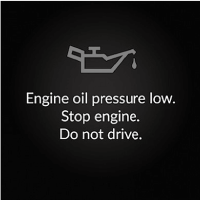If the Engine oil pressure low Warning Appears
-
Reasons for the warning to appear
Appears when the engine oil pressure is low.
What to do as soon as the warning appears
- Immediately park the vehicle on level ground in a safe place.
- If necessary, turn the hazard warning lights on.
What to do after parking the vehicle
- Stop the engine and let it sit for approximately three minutes.
- Open the hood and check the oil level.
- Add oil as necessary.
- Start the engine and check the Engine oil pressure low warning.
- The warning disappears: Start driving again.
- The warning does not disappear within 10 seconds: Immediately stop the engine and contact a dealer for repairs.
-

- Detail
-
NOTICE
Running the engine with low oil pressure can cause serious mechanical damage almost immediately.
If the Charging System Indicator Comes On
- Detail
-
If you need to stop temporarily, do not turn off the engine. Restarting the engine may rapidly discharge the battery.
If the Malfunction Indicator Lamp Comes On or Blinks
-
Reasons for the indicator lamp to come on or blink
- Comes on when there is a problem with the engine emissions control system.
- Blinks when engine misfiring is detected.
What to do when the indicator lamp comes on
Avoid high speeds and immediately get your vehicle inspected at a dealer.
What to do when the indicator lamp blinks
Park the vehicle in a safe place with no flammable items and wait at least 10 minutes or more with the engine stopped until it cools.
-

- Detail
-
NOTICE
If you drive with the malfunction indicator lamp on, the emissions control system and the engine could be damaged.
If the malfunction indicator lamp blinks again when restarting the engine, drive to the nearest dealer at 31 mph (50 km/h) or less. Have your vehicle inspected.
If the Brake System Indicator (Red) Comes On or Blinks
-
Reasons for the indicator to come on
- The brake fluid is low.
- There is a malfunction in the brake system.
What to do when the indicator comes on while driving
Depress the brake pedal lightly to check pedal pressure.
- If normal, check the brake fluid level the next time you stop.
- If abnormal, take immediate action. If necessary, downshift the transmission to slow the vehicle using engine braking.
Reason for the indicator to blink
There is a problem with the electric parking brake system.
What to do when the indicator blinks
Avoid using the parking brake and have your vehicle checked by a dealer immediately.
-

- Detail
-
Have your vehicle repaired immediately.
It is dangerous to drive with low brake fluid. If there is no resistance from the brake pedal, stop immediately in a safe place. If necessary downshift the gears.If the brake system indicator (red) and ABS indicator come on simultaneously, the electronic brake distribution system is not working. This can result in vehicle instability under sudden braking.
Have your vehicle inspected by a dealer immediately.If the brake system indicator (red) blinks at the same time when the brake system indicator (amber) comes on, the parking brake may not work.
Avoid using the parking brake and have your vehicle checked by a dealer immediately.
If the Brake System Indicator (Red) Comes On or Blinks at the Same Time When the Brake System Indicator (Amber) Comes On
-
If the brake system indicator (red) comes on or blinks at the same time when the brake system indicator (amber) comes on, release the parking brake manually or automatically.
- If the brake system indicator (red) continuously comes on or blinks at the same time when the brake system indicator (amber) comes on, stop the vehicle in a safe place and have it inspected by a dealer immediately.
- Preventing the vehicle from moving, put the transmission into P.
- If only the brake system indicator (red) is turned off, avoid using the parking brake and have your vehicle checked by a dealer immediately.
- If the brake system indicator (red) continuously comes on or blinks at the same time when the brake system indicator (amber) comes on, stop the vehicle in a safe place and have it inspected by a dealer immediately.
-

- Detail
-
If you apply the parking brake, you may not be able to release it.If the brake system indicator (red) and the brake system indicator (amber) come on at the same time, the parking brake is working.If the brake system indicator (red) blinks at the same time when the brake system indicator (amber) comes on, the parking brake may not work because it is checking the system.
If the Electric Power Steering (EPS) System Indicator Comes On
-
Reasons for the indicator to come on
Comes on when there is a problem with the EPS system.
What to do when the indicator comes on
- Stop the vehicle in a safe place and restart the engine.
If the indicator comes on and stays on, immediately have your vehicle inspected by a dealer. - If Do not drive displays on the driver information interface, immediately stop in a safe place and contact a dealer.
- Stop the vehicle in a safe place and restart the engine.
-

If the Low Tire Pressure/TPMS Indicator Comes On or Blinks
-
Reasons for the indicator to come on or blink
A tire pressure is significantly low, or the TPMS has not been calibrated. If there is a problem with the TPMS, the indicator blinks for about one minute, and then stay on.
If the compact spare tire is installed, the indicator will either come on or it will first blink for about one minute, then stay on.What to do when the indicator comes on
Drive carefully and avoid abrupt cornering and hard braking.
Stop your vehicle in a safe place. Check the tire pressure and adjust the pressure to the specified level. The specified tire pressure is on a label on the driver side doorjamb.
- Calibrate the TPMS after the tire pressure is adjusted.
What to do when the indicator blinks, then remains on
Have the tire inspected by a dealer as soon as possible. If the compact spare tire causes the indicator to first blink, and then stay on, change the tire to a full-size tire.
The indicator goes off after calibrating the TPMS. - Calibrate the TPMS after the tire pressure is adjusted.
-

- Detail
-
NOTICE
Driving on an extremely underinflated tire can cause it to overheat. An overheated tire can fail. Always inflate your tires to the prescribed level.
- Recommended topic(s)


